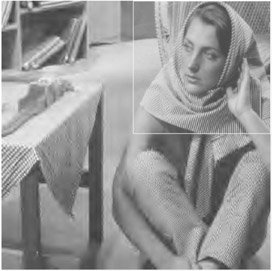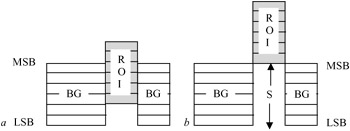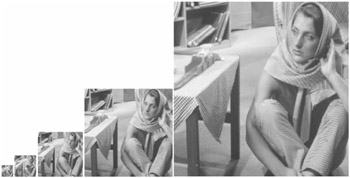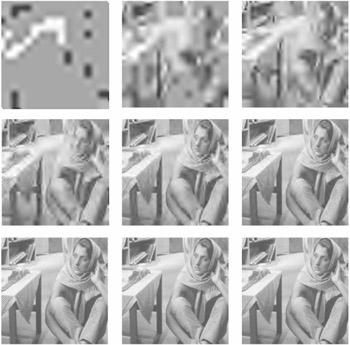5.5 Some interesting features of JPEG2000
5.5 Some interesting features of JPEG2000
Independent coding of code blocks and flexible multiplexing of quality packets into the bit stream exhibit some interesting phenomena. Some of the most remarkable features of JPEG2000 are outlined in the following.
5.5.1 Region of interest
In certain applications, it might be desired to code parts of a picture at a higher quality than the other parts. For example, in web browsing one might be interested in a logo of a complex web page image that needs to be seen first. This part needs to be given higher priority for transmission. Another example is in medical images, where the region of interest (ROI) might be an abnormality in the part of the whole image that requires special attention.
Figure 5.13 shows an example of a ROI, where the head and scarf of Barbara are coded at a higher quality than the rest of the picture, called the background. Loss of image quality outside the region of interest (outside the white box), in particular on the tablecloth, trousers and the books, is very clear.

Figure 5.13: Region of interest with better quality
Coding of the region of interest in the JPEG2000 standard is implemented through the so-called maxshift method [14]. The basic principle in this method is to scale (shift) up the coefficients, such that their bits are placed at a higher level than the bits associated with the background data, as shown in Figure 5.14. Depending on the scale value, S, some bits of the ROI coefficients might be encoded together with those of the background, like Figure 5.14a, or all the bits of the ROI are encoded before any background data are coded, as shown in Figure 5.14b. In any case, the ROI at the decoder is decoded or refined before the rest of the image.

Figure 5.14: Scaling of the ROI coefficients
It is interesting to note that, if the value of scaling S is computed such that the minimum coefficient belonging to the ROI is larger than the maximum coefficient of the background, then it is possible to have arbitrary shaped ROIs, without the need for defining the ROI shape to the decoder. This is because every received coefficient that is smaller than S belongs to the background, and can be easily identified.
5.5.2 Scalability
Scalability is one of the important parts of all the image/video coding standards. Scalable image coding means being able to decode more than one quality or resolution image from the bit stream. This allows the decoders of various capabilities to decode images according to their processing powers or needs. For example, although low performance decoders may decode only a small portion of the bit stream, providing basic quality or resolution images, high performance decoders may decode a larger portion of the bit stream, proving higher quality images. The most well known types of scalability in JPEG2000 are the SNR and spatial scalabilities. Since in JPEG2000, code blocks are individually coded, bit stream scalability is easily realised. In order to have either SNR or spatial scalability, the compressed data from the code blocks should be inserted into the bit stream in the proper order.
5.5.2.1 Spatial scalability
In spatial scalability, from a single bit stream, images of various spatial resolutions can be decoded. The smaller size picture with an acceptable resolution is the base layer and the parts of the bit stream added to the base layer to create higher resolution images comprise the next enhancement layer, as shown in Figure 5.15.

Figure 5.15: Spatial scalable decoding
In JPEG2000, due to the octave band decomposition of the wavelet transform, spatial scalability is easily realised. In this mode, compressed data of the code blocks has to be packed into the bit stream such that all the bit planes of the lower level subbands precede those of the higher bands.
5.5.2.2 SNR scalability
The signal-to-noise ratio (SNR) scalability involves producing at least two levels of image of the same spatial resolutions, but at different quality, from a single bit stream. The lowest quality image is called the base layer, and the parts of the bit stream that enhance the image quality are called enhancement layers. In JPEG2000, through bit plane encoding, the lowest significant bit plane that gives an acceptable image quality can be regarded as the base layer image. Added quality from the subsequent bit planes produces a set of enhanced images. Figure 5.16 shows a nine-layer SNR scalable image produced by bit plane coding from a single layer, where the compressed code block data from a bit plane of all the subbands is packed before the data from the next bit plane.

Figure 5.16: SNR scalable decoding
In Figure 5.16 the first picture is made up from coding the most significant bit of the lowest LL band. As bit plane coding progresses towards lower bits, more bands are coded, improving the image quality. Any of the images can be regarded as the base layer, but for an acceptable quality, picture number four or five may just meet
the criterion. The remaining higher quality images become its enhanced versions at different quality levels.
5.5.3 Resilience
Compressed bit streams, especially those using variable length codes (e.g. arithmetic coding) are extremely sensitive to channel errors. Even a single bit error may destroy the structure of the following valid codewords, corrupting a very large part of the image. Resilience and robustness to channel errors are the most desired features expected from any image/video encoder. Fortunately in JPEG2000, since the individual quality packets can be independently decoded, the effect of channel errors can be confined to the area covered by these packets. This is not the case with the other wavelet transform encoders such as EZW and SPIHT. Figure 5.17 shows the impact of a single bit error on the reconstructed picture, encoded by the SPIHT and JPEG2000. As the Figure shows, although a single bit error destroys the whole picture encoded by SPIHT, its effect on JPEG2000 is only limited to a small area, around Barbara's elbow. It is worth noting that the SPIHT encoder, even without arithmetic coding, is very sensitive to channel errors. For example, a single bit error in the early pass of LIS (refer to section 4.6) can corrupt the whole image, as can be seen from Figure 5.17a. In fact, this picture is not arithmetically coded at all, and the single bit error was introduced at the first pass of the LIS data. Of course it is possible to guard EZW and SPIHT compressed data against channel errors. For instance, if the bit stream generated by each tree of EZW/SPIHT can be marked, then propagation of errors into the trees can be prevented. This requires some extra bits to be inserted between the tree's bit streams as resynchronisation markers. This inevitably increases the bit rate. Since the resynchronisation marker bits are fixed in rate, irrespective of the encoded bit rate, the increase in bit rate is more significant at lower bit rates than at higher bit rates. For example, in coding Barbara with SPIHT at 0.1, 0.5 and 1 bit/pixel, the overhead in bits will be 2.7, 0.64 and 0.35 per cent, respectively.

Figure 5.17: Effect of single bit error on the reconstructed image, encoded by SPIHT and JPEG2000
EAN: 2147483647
Pages: 148